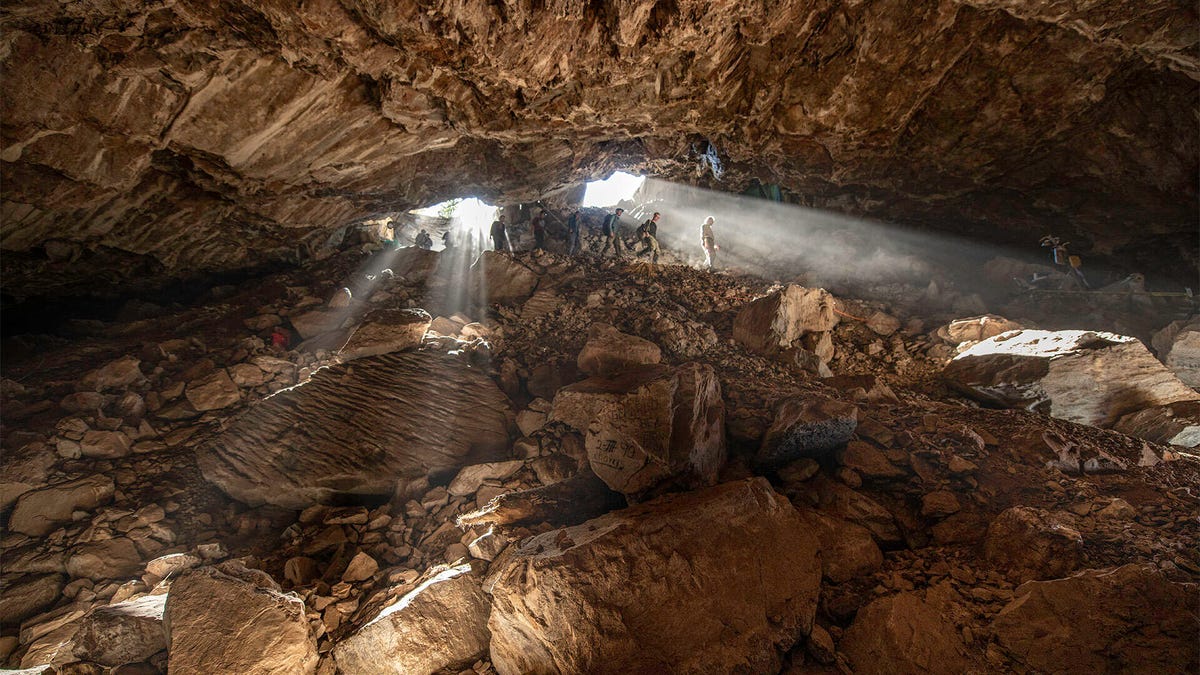Prehistoric 'hotel' found in Mexico shakes up understanding of human history
A painstaking excavation in an isolated and dangerous high desert finds people lived in the not-so-new world thousands of years earlier than previously thought.

Team members entering the Chiquihuite cave.
Exactly how long people have lived in the Western Hemisphere has been a topic of hot debate in archaeology circles going back at least to the 19th century. Two papers published in the journal Nature on Wednesday suggest humans were hanging out in Mexico as long as around 30,000 years ago.
I recall being taught not too long ago that humans were thought to have first populated the Americas via the Bering Sea land bridge between 12,000 and 20,000 years ago. However, recent excavations of Chiquihuite Cave in northern Mexico found new evidence that people were enjoying more temperate climes long before anyone made the icy trip from present-day Siberia to Alaska.
Analysis of almost 2,000 stone tools and sediment found in the high-altitude cave dated the artifacts to around 30,000 years ago.
"These early visitors didn't occupy the cave continuously, we think people spent part of the year there using it as a winter or summer shelter, or as a base to hunt during migration," Eske Willerslev, a DNA scientist and one of the leaders of the research, said in a release. "This could be the Americas' oldest ever hotel."
If it was a hotel, its ancient guests packed some odd things for their stays there.
"They're like stone tools made of a peculiar material... a recrystallized green limestone," archaeologist Ciprian Ardelean of the University of Zacatecas told the Nature podcast. "They used it to make very weird-looking artifacts that are oddly shaped. It's not the typical flint or obsidian you would find in many places."
The scientists think people may have used the cave seasonally while hunting the many species of mammals that lived nearby.
A stone tool found in the cave.
An international team with ties to St. John's College, the University of Cambridge, University of Copenhagen, Oxford University, the University of Zacatecas in Mexico and the University of New South Wales in Australia worked on the decade-long research project, centered on the cave in a region of Mexico controlled by drug cartels.
Interestingly, many of them also ended up using the cave as a sort of hotel. The researchers say they've spent many nights in the cave during its pain-staking and under-the-radar excavation over the past 10 years.
"It is a very unsafe place to travel so we were accompanied by Mexican police officers in armored cars to the foot of the mountain," said Mikkel Winther Pedersen, a geneticist from the University of Copenhagen. "We left before sunrise to climb up to the cave so that we weren't spotted."
The notion that humans may have been present in Mexico twice as long ago as previously thought brings up more questions than answers about the history of the Americas.
The second paper published in Nature takes into account the new discoveries from Chiquihuite Cave along with data from 42 other ancient sites to create a model for how human populations may have spread across the "New World" in the old days.
Assistant professor Mikkel Winther Pedersen with team members carefully sampling the different cultural layers in the cave.
"The data obtained show that humans were probably present before, during and immediately after the Last Glacial Maximum (about 19,000 - 26,500 years ago) but that more widespread occupation began during a period of abrupt warming (about 12,900 - 14,700 years ago)," the paper's summary reads.
It's been thought the Americas were unpopulated more than 19,000 years ago, because navigating the area would have required traversing huge walls of ice present in the Arctic and sub-Arctic at that time. But the evidence published this week suggests someone was here long before the big migration over the Bering bridge.
The shake-up of our understanding of American prehistory will likely lead archaeologists to reconsider other sites, like a handful in Brazil that have been dated to more than 20,000 years ago.
"Although expertly excavated and analyzed, (the sites) are commonly disputed or simply ignored by most archaeologists as being much too old to be real," writes anthropologist Ruth Gruhn in a column for Nature. "The findings at Chiquihuite Cave will bring about fresh consideration of this issue... In the light of these new discoveries, archaeological research into this period should intensify."

